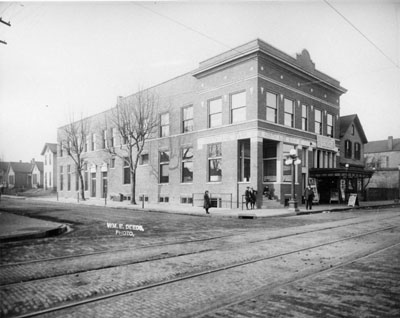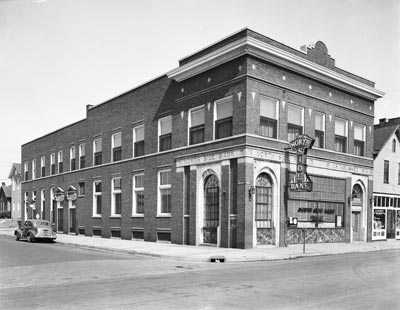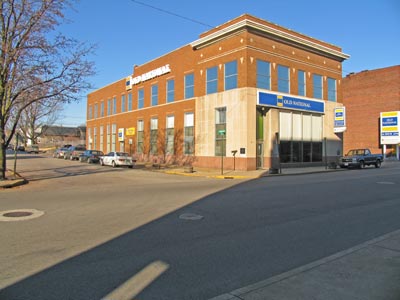
| Background Information |
Initially, film producers sold their products to exhibitors, usually at so much per foot, typically 10 cents a foot, a hundred dollars per reel. Exhibitors owned the film, but soon found that they could not practically own enough films to satisfy audiences demand. The solution was the growth of distributors who, for a fee, exchanged films among exhibitors. Eventually, rental rather than purchase became the norm. Under this arrangement, producers rented their films to exchanges, or distributors, who rented the films to exhibitors. Producers earned a percentage of what the film earned at the boxoffices of the nation. The percentage depended upon the drawing power of the individual film. The earliest exhibitors were often stores, banks, or other business who had the inclination and space to open a "nickelodeon," named for the cost of admission. The North Side Theater depicted to the right is an example of a nickelodeon. In some locations, vaudeville houses or the town's opera house, in Evansville the Grand Opera House, were converted to include a motion picture bill. By 1916 an estimated 28,000 theaters of all types existed in the country, and 400 to 500 films were produced each year. The 1920's were the decade of building theaters especially designed for film exhibitions. The Victory, built in 1921, is an example of such a building. During the decade of the 1920's, chains of motion pictures theaters emerged. For example, the Fabulous Fox Theater in St. Louis and the Fox in Detroit were part of the chain of theaters built by William Fox as venues for the films of Fox Productions. The largest chain of theaters was Paramount's with 2000 theaters. In Evansville, the Princess Theater was a Paramount Theater, never replaced after it burnt down. The second largest theater chain was First National, later to merge with Warner Brothers. Loew's Incorporated, created by Marcus Loew as the exhibitor for his film production company Metro Pictures, owned the third largest theater chain. Metro Pictures merged with Samuel Goldwyn Picture Corporation and Louis B, Mayer Picture Corporation to become Metro-Goldwyn-Mayer (MGM). In 1926, the Victory became a part of the Loew's theater chain. Thus, the Loew's Victory was the home of MGM pictures in Evansville, Indiana. During the 1920's about 80,000,000 people per week attended motion pictures. The feature presentation, the "A" production, cost an average of $200,000. The typical movie bill included the feature and preceding shorts. These shorts were called program pictures (to fill out the program) and were "B" and "C" level productions. Program material usually came from the same major production companies using major facilities, but they had lower budgets, shorter shooting schedules, and lesser known stars and directors. Some minor studios specialized in program pictures. The production, distribution, and exhibition framework set the stage for Hollywood's Golden Age of the 1930's and 1940's. The missing ingredient was sound. |
|
| Click to go to Silent Era Section |
 |
| Photo Courtesy Willard Library |
| North Main Nickelodeon at North Main and Indiana in 1913. |
 |
| Photo Courtesy of Willard Library |
North Side Bank in the 1940's. Notice the nickelodeon is gone. By the 1940's theaters built exclusively for motion picture exhibition had driven nickelodeons either to convert to modern theaters or to close. |
 |
| Photo by Terry W. Hughes December 19, 2005 |
This photograph does show that the basic building with alterations still stands at the corner of North Main and Indiana.
|